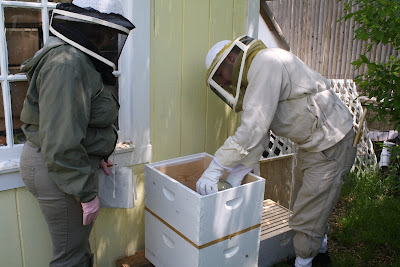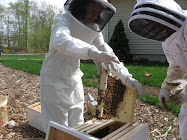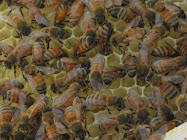On Saturday three of us from our bee keeping class got together to do hive checks. Not only do you get more exposure to bees and different hives, but you also have an extra pair of hands to take pictures! At my house, both Benjamin and Victor were able to observe as well. (Ripley played nicely in the driveway.)
Sarah has two hives at her house: her hive and long time friend Joel's hive. It seems as though every hive has its own adventure enclosed. Joel's hive has a lot of drone comb, which when capped makes a little bump-out rather than being flat because drones (boy bees) are larger than the worker bees. (And, isn't it funny that JOEL'S hive has more drone comb than ours?)

See the drone cells below? They look like the round puffy end of a piece of popcorn.

Joel inspecting one of his frames.

The string of bees in between these frames is called "festooning".
They hang or string together when creating wax.
Good little bees.

Sarah going into her hive.

This week Joel and Sarah shook confectioners sugar into their hives to battle the varroa mite (a major problem for the honey bee). We call it "The Sugar Shake". Basically, to take one cup of confectioner's sugar and shake it over your hive either in a thin strainer or flour sifter. Then, you brush the sugar off the tops of the frames down into the hive. We all have screened bottom boards, so when the bees groom the yummy sugar off themselves and each other, the varroa mite falls off the bees and down through the screened bottom board out of the hive. You repeat this every three weeks.

This is just the beginning. A full cup of sugar is a lot. The poor little bees don't look all that happy -- completely covered in powdered sugar.

But, they are pretty funny to watch flying around like white ghosts.
Here is one on a blade of grass trying to determine just what she did to get herself into this mess.

Now, at last, to my hives. You may recall that last week I put on the second brood chambers on both of my hives. Of course every bee keeper has their own opinion on the subject of when to put on your second brood chamber. Seeing as I am a skittish new bee keeper, I went with the most conservative theory. Which is: When the bees have started building out comb on frames 2 and 7 (out of 8 frames) go ahead and add the next brood chamber. This is for frames with foundation (and not built out comb) which is to say, they still need to make the comb before the queen can lay eggs. The reason for this is: it gives the bees a chance to start building out comb on the upper chamber at the same time as they are finishing the lower chamber. In this way, they wont start to feel crowded. A friend of mine in her first year of bee keeping lost her bees to a swarm in this way. Although, bee keeping is not an exact science, more like an art form. Some bee keepers swear by waiting until they are well on their way to working on the last 2 frames before putting on the next chamber.
The good news for me was that the bees in my right hive were working at building comb on one frame in the upper brood chamber! The bees in my left hive were just getting started. So, we've made some progress and they have plenty of room.
Here are the bees busy starting on building comb on their first frame in the upper brood chamber.

In the lower chamber there was a lot of evidence of the birth of new bees. It takes 21 days for a worker bee to be born and my bees were installed on April 26th, my queens released on approximately April 30th, so as of May 21st new bees should be hatching everyday.
On the left side of the picture below you can see "capped brood" which is the last stage of creating a baby bee where the worker bees enclose the larvae in it's individual cell to finish developing.
When the baby bees hatch, you will see empty comb (see the middle of the picture). If you look closely, you can see a baby hatching out! Can you find it?

Here, I'll help you. See?

I saw both of my queens in each of my hives, and freshly laid eggs. A wonderful sight for the bee keeper. All is well.

The big event during my hive check was removing a very large piece of burr comb that the bees in my left hive build and the queen laid eggs into. I didn't have the heart to yank it out before a good number of the baby bees had hatched out. When I was inspecting this frame, Sarah and Victor (looking on without his veil, again) noticed that this burr comb was dangling from a small attached portion at the top. So, with encouragement from 'the crowd' Victor and Sarah grabbed hold of the burr comb with their gloved hands and yanked it off slowly. It was a bit sad because there were still unborn bees in the comb, but it had to be done. I cleaned up the rest of the area with my hive tool. Now this frame sits nicely against it's neighboring frame as it's supposed to. To get the remaining worker bees off the burr comb, I gave it a puff a smoke, and Sarah gave it a good shake or two. The rest found their way back into the hive after we set the comb on the ground next to the front entrance.































1 comment:
So your burr comb that had babies in it, will they hatch & find their way into the hive? or not so much? Thanks for sharing I really enjoy reading about it. Oh & I found the baby bee hatching before U pointed it out. :)
Post a Comment